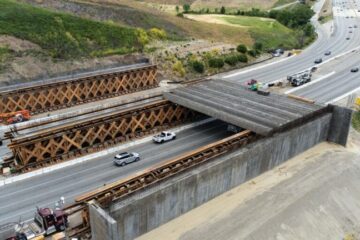Rare Pupfish in Mojave on Brink of Extinction
In the best of times, the desert’s a tough place for a fish. At Devil’s Hole, times have been better.
Source of this article – Los Angeles Times, February 6, 2006.
By Louis Sahagun, Times Staff Writer

GUARDIAN: David Ek of the National Park Service points to a pupfish in Devil’s Hole, Nev. Two years ago hundreds of the fish lived in the pool, part of the Death Valley park. Fewer than 80 remain. (Stephen Osman / LAT)
SHOSHONE, Calif. — The imperiled Devil’s Hole pupfish, which has been clinging to existence in a remote rock tub in the Mojave Desert since the Ice Age, may not survive another year, federal biologists warned.
Regional groundwater pumping, mysterious changes in mating behaviors and habitat disruptions inadvertently caused by scientists who have been trying to protect the pupfish are being blamed for decimating the species, long regarded as a symbol of the desert conservation movement.
In a tragedy that was not publicly announced, scientists two years ago accidentally killed 80 of the iridescent blue fish — about one-third of the population at the time. Fewer than 80 of the inch-long fish still swim in the spa-like turquoise waters of a small pool at the bottom of an isolated limestone depression that became part of Death Valley National Monument — now a national park — by proclamation of President Truman in 1952.
Only two years ago, the fish, whose plight escalated into a highly publicized U.S. Supreme Court battle in 1976, numbered in the hundreds.
“We’re definitely concerned that the population has fallen to so low a number it may not be able to rebound,” said Cynthia Martinez, assistant field supervisor of the U.S. Fish and Wildlife Service’s Southern Nevada office. “This is the lowest number ever. It’s a very serious situation.”

DWINDLING: The inch-long pupfish have been devastated by groundwater depletion, low fertility and a 2004 accident. (Stephen Osman / LAT)
David Ek, an assistant chief with the National Park Service in Death Valley, put it this way: “If they don’t breed this spring — the height of the breeding season — they’ll be gone in a year, year and a half.”
On Thursday, a special recovery team is expected to convene in Las Vegas to weigh possible emergency measures, then make recommendations to Fish and Wildlife managers and National Park Service Regional Manager John Jarvis.
Options include capturing fish and breeding them in controlled conditions elsewhere, then restocking Devil’s Hole with the offspring, or just leaving the site alone in hopes the fish can rebound without human help.
Time is running out, biologists said, because of the precarious life cycle and population dynamics of what ichthyologists call one of the rarest fish in the world in one of the world’s most restricted habitats.
“Threats abound,” said Death Valley biologist Linda Manning. “This fish is almost infertile, with females laying up to 10 eggs in their 10-month life span. So we’re hoping there are enough fish of breeding age to begin spawning.”
Scientists from California and Nevada have worked for decades to save the fish. About 30 miles north of this Mojave Desert village, Devil’s Hole is part of Death Valley National Park, even though it lies in Nevada outside the main park boundary.

FENCED OFF: A barrier topped with barbed wire surrounds Devil’s Hole. It was erected in an effort to protect the fish, whose fate was the focus of a 1976 Supreme Court battle as conservationists fought to stem the pumping of water for irrigation. The court ruled for the fish. (Stephen Osman / LAT)
Carl L Hubbs, known as the father of Western ichthyology, persuaded Truman to have the unique fish and its pocket ecology added to Death Valley as a protective measure.
“I like to call these unique specimens ‘pupfish’ because they play just like puppies,” Hubbs said at the time.
There are other kinds of pupfish in the desert, but the Devil’s Hole species is unique — as is its unlikely home.
The “hole” is a large, sloping depression with a pool of water at the base. The pool is just 10 feet across and 70 feet long but amazingly deep. Divers have ventured down 468 feet without reaching the bottom.
Key to the pupfish’s survival is a 23-square-yard slab of rock that juts out into the pool, just a few inches below the surface. The fish spawn on the slab, which often is covered with layers of gravel and pebbles washed into the pool by rain.
Water temperatures average about 93 degrees, and the fish’s primary food source, a thin blanket of green algae, grows here.
On a recent weekday, a dozen pupfish could be seen browsing among the submerged algae meadows, paddling slowly or darting off to chase away invaders. This habit of nipping at each other’s tails is what reminded Hubbs of puppies when he named them.
Beyond the shelf, where the pool becomes deep, the water is tinted blue by high concentrations of minerals, including calcium carbonate.
In ancient times, the Timbisha Shoshone tribe regarded Devil’s Hole as a mythical home of the child-swallowing giant called Tso’apittse. Later, Death Valley 49ers liked to bathe in the warm mineral waters shared by the tiny fish that tickled their toes.
The Devil’s Hole pupfish thrived until the late 1960s, when the water level and pupfish population began to fall precipitously because of irrigation pumping.
The population crash triggered a classic environmental clash between conservationists, who wanted to stop the pumping to save the fish, and locals who placed a higher value on economic growth.
Two popular bumper stickers at the time were “Save the Pupfish” and “Kill the Pupfish.”
The conflict ended up in the U.S. Supreme Court, where it was resolved in favor of the pupfish. Later, federal authorities tried to secure the creature’s future by surrounding the hole with barbed wire fences and radio antennas.

ISOLATED HABITAT: Instruments monitor the water at Devil’s Hole, reached by a dusty desert road. On Thursday (Feb. 9) a team is expected to convene in Las Vegas to weigh emergency measures. One option is to try to breed the fish in captivity and return them. (Stephen Osman / LAT)
But the pupfish’s troubles were far from over.
Over the last decade, “for as yet unknown reasons, we’ve seen a gradual decline in population,” said James Deacon, a University of Nevada emeritus professor of environmental studies and the leading expert on the pupfish. “It may be because a larger percentage of fish have been laying their eggs in the deeper water, where they can’t develop as well.”
Deacon has also discovered that security fences rimming the Devil’s Hole have prevented gravel and pebbles from washing into the pool. Such infusions are needed to renew the pupfish’s habitat.
He’s also concerned that a metal walkway, suspended over the pool and used by federal divers to avoid stepping on the rock shelf, has somehow affected the fish’s environment.
Then there was the pupfish crisis of Sept. 11, 2004: Empty fish traps had been stacked by researchers on dry land, but a flash flood sent them tumbling into the pool. The traps, made of glass jars outfitted with inverted funnels, were used by researchers who caught, studied, then quickly released the fish.
“A week later, we returned to discover jars floating on the shelf, or broken,” recalled Manning. “Many of those intact had expired fish in them. We lost about 80 fish.
“It was a stunning, horrible, nauseating discovery,” she said.

DESERT ROAD: A truck kicks up dust as it travels on the desert road leading to Devil’s Hole in Death Valley. (Stephen Osman / LAT)
The incident was immediately reported to park officials, who said they did not announce the accident to the public at the time because they were overwhelmed by flood-related problems throughout the park.
Biologists fear that, given their short lifespan and troubled breeding cycles, as few as 50 pupfish will remain in the pool by the time mating season arrives.
About 40 more Devil’s Hole pupfish are being studied in artificial conditions at a Fish and Wildlife facility at Hoover Dam. Those fish, too, however, are steadily declining in numbers.
Surveying a dozen survivors meandering about in the hole on the southern flanks of a isolated and barren crimson mountain, Ek said, “Doing nothing doesn’t seem a realistic alternative.
“But with the population so low and in decline, we don’t have much room for error,” he said. “Whatever we do, we have to do it quickly.”


